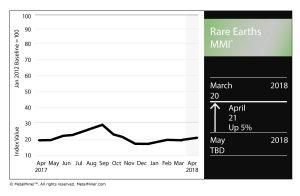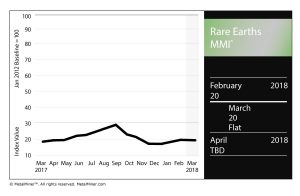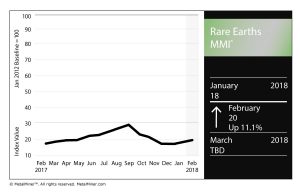The Rare Earths Monthly Metals Index (MMI) held flat this month, again hitting an MMI reading of 17. Need buying strategies for steel? Request your two-month free trial of MetalMiner’s Outlook China Denies Report it is Limiting Rare Earth Output China’s dominance in the rare earths sector is well-documented. The country’s sway in the market is […]
Tag: rare earths MMI
Rare Earths MMI: U.S. Drops Rare Earths From $200B Tariff List
The Rare Earths Monthly Metals Index (MMI) stood pat this month for an MMI value of 17. Need buying strategies for steel? Request your two-month free trial of MetalMiner’s Outlook Pentagon Reviews Critical Materials Dependence Tariffs have been flying left and right this year, impacting a wide range of products, from steel and aluminum to […]
Rare Earths MMI: China’s Ministry for Industry and Information Technology Raises Rare Earths Quota
The Rare Earths Monthly Metals Index (MMI) dropped one point this month, falling for a reading of 17. Metal Buying Outlook: Request Your Two-Month Free Trial China Raises Quota for Rare Earth Smelting, Separation On Aug. 27, China’s Ministry for Industry and Information Technology announced it would increase the quota on rare earth smelting and separation. […]
Rare Earths MMI: Rare Earths Appear on Trump Administration’s Proposed $200B Tariff List
The Rare Earths Monthly Metals Index (MMI) fell one point for an August reading of 18. Need buying strategies for steel? Try two free months of MetalMiner’s Outlook Rare Earths and Trade Tensions Much has been said about the rise of trade tensions around the world, particularly between the U.S. and China. Those tensions began to manifest […]
Rare Earths MMI: Toyota, Other Firms Team Up With Scientists to Develop Undersea Rare Earths Extraction Technology
The Rare Earths Monthly Metals Index (MMI) stood pat this month, holding for a reading of 19. Need buying strategies for steel? Try two free months of MetalMiner’s Outlook The Search for Rare Earths As we noted in an MMI post earlier this year, the discovery of a large deposit of undersea rare earths approximately […]
Rare Earths MMI: Subindex Slides Back One Point
The Rare Earths Monthly Metals Index (MMI) dropped one point this month for a June reading of 19. Need buying strategies for steel? Try two free months of MetalMiner’s Outlook Under the Sea In April, researchers announced that a massive source of rare earths had been located just over 1,000 miles southeast of Tokyo. The catch? […]
Rare Earths MMI: Researchers Discover Rare Earths Deposit Under Japanese Waters
The Rare Earths Monthly Metals Index (MMI) lost one point this month, dropping to 20 for our May reading. Need buying strategies for steel? Try two free months of MetalMiner’s Outlook Within this basket of metals, yttrium dropped slightly, while terbium oxide fell 7.8%. Neodymium oxide dropped 7.9%. Europium oxide fell 0.9%. Dysprosium oxide fell […]
Rare Earths MMI: Metals Prices Move Up, Demand for Neodymium Grows
The Rare Earths Monthly Metals Index (MMI) picked up a point this month, rising from 20 for an April reading of 21.
The basket of metals posted price gains across the board this past month.
Need buying strategies for steel? Try two free months of MetalMiner’s Outlook
Yttrium rose 1.2%, while terbium oxide rose 1.6%. Neodymium oxide rose 0.2%, europium oxide was up 1.3% and dysprosium oxide was up 0.8%.
Growing Demand for Neodymium
A move by Tesla to a magnetic motor for its Model 3 Long Range car, Reuters reported last month, will add pressure on an already constrained neodymium market.
According to the research group imarc, the market for the neodymium-iron-boron magnet used for the magnetic motors is now worth more than $11.3 billion, Reuters reported.
Global demand for neodymium exceeded supply by 3,300 tons, according to the report.
With the demand for electric vehicles growing more and more, so too will the demand for rare-earth metals like neodymium. Complicating the supply landscape, however, is China’s total dominance in the rare earths market. Given rising trade tensions, stemming from the Trump administration’s recent Section 232 steel and aluminum tariffs, plus the recent Section 301 announcement — the Office of the United States Trade Representative yesterday posted a proposed list of Chinese products that could be subject to tariffs — the neodymium supply market is something to be monitored.
As Reuters notes, China previously instituted a neodymium export ban, which was lifted in 2015 — could it happen again? That remans to be seen, but increasingly inflamed global trade relations certainly don’t do anything to tamp down the possibility.
Speaking of Trade Tensions…
Bloomberg speculated last month on ways China could retaliate against the U.S. should the latter eventually impose tariffs on Chinese goods amounting to potentially $50-$60 billion.
The article notes that in 2010, China stopped giving Japan export licenses for rare earth metals used in cars and electronics, as a result of tensions related to islands in the East China Sea.
Again, it remains to be seen what the rising tensions mean for the rare-earths market, but it is certainly worth monitoring going forward.
Searching from Above
In the search for new deposits of rare earths (and metals, in general), scientists are looking from a bird’s eye view — or, rather, a drone’s eye view.
According to a report in The Guardian, German scientists are using drones to scout out potential new sources of metals. The scientists are using drones, equipped with special cameras and sensors, to identify potential deposits based on the unique reflections of light various minerals produce, according to the report.
As noted above, the demand for rare earth materials is only going to increase, not just for application in electric vehicles, but also in other high-tech products.
MetalMiner’s Annual Outlook provides 2018 buying strategies for carbon steel
Actual Metal Prices and Trends
Rare Earths MMI: Toyota Develops Neodymium-Reduced Magnet
The Rare Earths MMI (Monthly Metals Index) held steady, notching a reading of 20 for our March MMI.
Need buying strategies for steel? Try two free months of MetalMiner’s Outlook
Within the basket of metals, Chinese yttrium dropped slightly, while terbium metal picked up in price.
Europium oxide also dropped slightly, while dysprosium oxide picked up an extra dollar per kilogram.
New Toyota Magnet Not Dependent on Some Rare-Earth Minerals
According to a report by Ars Technica, a new magnet developed by automaker Toyota will not be dependent on some key rare-earth minerals.
Toyota announced it had invented a magnet — for application in electric vehicles — that uses much less of the rare-earth mineral neodymium. According to Toyota, it had developed “the world’s first neodymium-reduced, heat-resistant magnet.”
Of course, cost is a major restraining factor when it comes to electric vehicle (EV) growth. Materials needed for EV batteries, like neodymium, are costly, and many battery makers have sought to reconfigure the percentages of metals used in their batteries to phase out more cost-prohibitive materials (like cobalt, for example).
In addition to reducing the use of neodymium, the new magnet also completely phases out two other rare earth minerals.
“The newly developed magnet uses no terbium (Tb) or dysprosium (Dy), which are rare earths that are also categorized as critical materials necessary for highly heat-resistant neodymium magnets,” according to the Toyota statement. “A portion of the neodymium has been replaced with lanthanum (La) and cerium (Ce), which are low-cost rare earths, reducing the amount of neodymium used in the magnet.”
According to the announcement, the new magnet reduces the amount of neodymium used by as much as 50%.
Europium Market to Hit $308.9M by 2025
The global europium market is set to hit a value of $308.9 million by 2025, according to a recent report by Reportbuyer.
According to the report, consumer electronics, automotive, semiconductors, and energy and mining are the sectors leading the charge in the growth of europium.
Want to see an Aluminum Price forecast? Take a free trial!
Actual Metal Prices and Trends
Rare Earths MMI: U.S. National Energy Technology Lab Works on Rare Earth Element Recovery Projects
The Rare Earths MMI (Monthly Metals Index) hit 20 for our February meeting, up from 18 last month.
Several of the heavier hitters in the basket of metals posted price increases this past month. Yttrium jumped 3.3%, while terbium oxide rose 12.4%.
Neodymium oxide surged 11.3% and dysprosium oxide rose 6.0%.
U.S. Lab Works to Increase Rare Earth Element Recovery
As we mention here every month, China has overwhelming control of the global rare earths market, meaning supply-side squeezes in the country often yield price spikes for the valuable materials used in things from electric vehicles to smartphones.
Unsurprisingly, the U.S. is looking for ways to increase its ability to recover rare earth elements (REEs) in domestic supplies of coal.
According to the National Energy Technology Laboratory (NETL), it is taking steps toward that goal.
“Four rare earth elements (REEs) recovery projects managed by the U.S. Department of Energy’s (DOE) Office of Fossil Energy and the National Energy Technology Laboratory (NETL) have made significant progress in the development of a domestic supply of REEs from coal and coal by-products by successfully producing REE concentrates,” a NETL release states.
The lab has run four test projects in different parts of the country. According to the release, the results of the projects are as follows:
-
Physical Sciences, Inc. (pilot-scale project) achieved 40 percent REE concentration at 15 percent REE recovery using post-combustion fly ash from burning Central Appalachian Basin coal. Field implementation and testing of physical processing technology will occur in Kentucky, with subsequent chemical processing in Pennsylvania.
-
The University of Kentucky (pilot-scale project) achieved greater than 80 percent REE concentration at greater than 75 percent REE recovery using Central Appalachian Basin and Illinois Basin coal preparation plant refuse. The project team plans to implement and test their technology at multiple field locations in Kentucky.
-
The University of North Dakota (bench-scale project) achieved 2 percent REE concentration at 35 percent REE recovery using North Dakota lignite coal. The University will build and test the technology in their laboratory.
-
West Virginia University (WVU) (bench-scale project) achieved 5 percent REE concentration at greater than 90 percent REE recovery using acid mine drainage solids from the Northern Appalachian and Central Appalachian Basins. WVU plans to build and test their unit in the WVU laboratory.
Of course, any new domestic capacity to recover REEs in the U.S. will be met with happiness by domestic end users, who have to pay a fortune for these rare and valuable materials.
Southeastern Alaska Town to be New Home of Rare Earths Plant
According to the a report in Mining News, the town of Ketchikan, Alaska, was chosen to be the new home of a rare earths processing facility.
Ucore Rare Metals Inc. picked the southeastern Alaska town for a new planned strategic metals complex (SMC).
“Engineering and economic studies have confirmed that Ketchikan is our preferred location to construct our first strategic and critical metals separation facility” said Mike Schrider, Ucore’s vice president of operations and engineering, in a company release. “Additional engineering and product specification criteria are being initiated at this time targeting rare earth by-products and primary concentrates from non-Chinese sourced projects world-wide. The intent is also to maintain the processing flexibility and capacity to accommodate ore concentrate from the Bokan-Dotson Ridge Project, once that project has been developed.”
According to the release, among other factors, Ketchikan’s proximity to the container port and rail head at Prince Rupert was cited as part of the locale’s desirability for the new SMC.
“Ketchikan features deep water port, barge-container facilities and direct access to markets in the US and the Pacific Rim by way of ocean vessel, the lowest-cost mode of bulk transport,” the release states. “Ketchikan offers a unique work force, ice-free harbors and is in close proximity to Ucore’s flagship in-situ development project, the Bokan Dotson-Ridge Rare Earth Project (“Bokan”).





